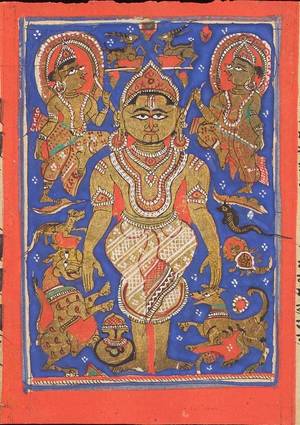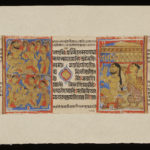Article: Jina
The term Jina means ‘spiritual victor’ in Sanskrit and describes a human being who has achieved omniscience and then teaches other people the path to liberation – mokṣa-mārga – from the cycle of rebirth. The term is used interchangeably with Tīrthaṃkara. This is Sanskrit for ‘ford-maker’ – that is, a person who builds a ford – tīrtha – across the river of rebirth.
Jinas are neither divine beings nor avatars of gods. They are enlightened human beings who spread the unchanging principles of Jainism. Jains believe that spiritual progress, which aims towards eventual enlightenment and liberation, is the responsibility of each soul. Jinas are removed from everyday human life and do not respond to the prayers of believers. Each Jina has a yakṣa and a yakṣī, often depicted in art. As gods, these attendants are not liberated and thus can act in the affairs of human beings.
As in many matters, the two main Jain sects of Digambara and Śvetāmbara hold different views on certain aspects of the Jinas. This is given most obvious expression in the artistic styles of each sect, which are quite distinct.
This piece is a summary of the article "Jina". The full article will be available soon.
The 24 Jinas
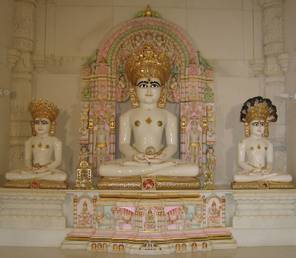
Śvetāmbara figures of Ṛṣabha, Māhavīra and Pārśva
Image by unknown © Oshwal Association of the UK (OAUK)
According to traditional Jain cosmology, time flows in an endless cycle in the Lands of Action, where human beings live. Each cycle of time is made up of 12 periods. In each cycle 24 Jinas are born, during the periods when life is comparatively harsher in terms of knowledge, lifespan, stature, pleasure, morality and spirituality. These conditions make it harder to lead a virtuous life and advance spiritually so the Jinas offer guidance to believers, reminding them of eternal truths. However, Jinas do not appear in the worst times, perhaps partly because these are the lowest points of the time cycle.
In this era the first Jina was Ṛṣabhanātha or Lord Ṛṣabha and the last Mahāvīra. The historical existence of Mahāvīra and his predecessor, the 23rd Jina Pārśvanātha or Lord Pārśva is generally accepted, but there is no historical evidence for the other Jinas.
Life of a Jina
The lives of all the Jinas follow the same pattern, revolving around five key events:
- conception – cyavana
- birth – janma
- initiation into monastic life – dīkṣā
- enlightenment – kevala-jñāna
- final liberation – nirvāṇa or mokṣa.
Jains celebrate these auspicious moments – kalyāṇakas – on special occasions.
The oldest text giving details of some of the Jinas’ lives is the Śvetāmbara Kalpa-sūtra. But in the course of time both Śvetāmbaras and Digambaras have produced a vast body of literature narrating in detail the lives of all Jinas, including their previous births. As the literature grew, so these tales of their lives featured an increasing number of episodes. Standard representatives of this genre are the Śvetāmbara Lives of the 63 Illustrious Great Men – Triṣaṣṭi-śalākā-puruṣa-caritra – and on the Digambara side, the Mahā-purāṇa. They are both in Sanskrit. The former text was written by the 12th-century monk, Hemacandra, while the Digambara ascetics Jinasena and Guṇabhadra composed the latter in the ninth century. As counterparts to the Hindu Purāṇas, such texts act as a storehouse of various legends and define what is known as ‘Universal History‘.
Conception and birth
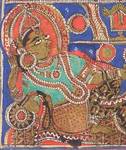
Marudevī has the auspicious dreams
Image by Wellcome Trust Library © Wellcome Library, London
- The mother of a Jina-to-be experiences a sequence of auspicious dreams at conception or during pregnancy.
- The child who will become a Jina is born into the kṣatriya caste.
- They are born with tremendously strong bodies, enabling them to survive the extreme physical and mental austerities needed to get rid of the karma from previous lives.
Renunciation
- The child is a prince, brought up in luxury and enjoying the pleasures of the world.
- The gods remind the young man of his great destiny as a Jina, prompting him to give up the ease of his worldly life and become a monk.
Enlightenment
- The monk is a ‘perfect ascetic’, exemplary in his behaviour and spirituality.
- He undergoes a series of gruelling physical and mental trials – upasarga – that tests his strength and mental fortitude to the limit before he can purge his soul of karma.
- While meditating under a tree, the ascetic reaches enlightenment, equivalent to absolute knowledge or omniscience.
- The gods build an assembly hall for the new Jina, who preaches his first sermon – samavasaraṇa – to all animals, gods and human beings using the divine sound – divya-dhvani.
- The Jina forms a fourfold community consisting of monks, nuns, lay men and lay women.
- His teachings are collected into Āgamas by his chief disciples – gaṇadharas.
Liberation
- Towards the end of his life, the Jina practises special meditations – dhyāna – that end the activity of his body, speech and soul.
- His soul is emancipated from the cycle of rebirth and instantly rises to the siddha-śilā, where all liberated souls delight in neverending bliss
- Once the Jina’s soul is in the siddha-śilā as a paramātman, it remains separated from the other liberated souls.
Sources
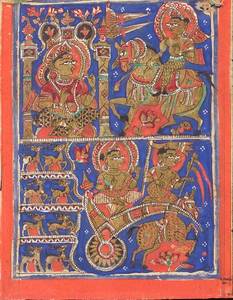
Nemi’s renunciation
Image by Wellcome Trust Library © Wellcome Library, London
The main source of information about the lives of the Jinas is the first part of the Kalpa-sūtra, called the ‘Lives of the Jinas’ – Jina-caritra. This Śvetāmbara text is attributed to Bhadrabāhu although the date of composition is unknown. The ‘Lives of the Jinas’ consists of biographies of four of the 24 Jinas who are important figures of worship. They are, in order:
- Mahāvīra, the 24th Jina
- Pārśvanātha or Lord Pārśva, the 23rd
- Neminātha or Lord Nemi, the 22nd
- Ṛṣabhanātha or Lord Ṛṣabha, the first
The lives of the remaining 20 Jinas are sketched much more briefly and are closer to outlines of key events than to narratives.
Other Śvetāmbara canonical sources for the lives of the Jinas are:
- the Ācārānga-sūtra, the first book of the canon, where the ascetic career of Mahāvīra and the hardships he undergoes are depicted quite realistically
- the 22nd chapter of the Uttarādhyayana-sūtra, in which a famous episode dramatically relates how the 22nd Jina, Nemi, decides to renounce the world just before his wedding ceremony.
Differences between Digambaras and Śvetāmbaras
The two main Jain sects of the Digambaras and the Śvetāmbaras differ in their beliefs about Jinas. These are relatively minor and partly relate to disagreements over whether women can gain liberation and whether monks should be nude.
When the Jinas are represented in Mūrti-pūjaka art, the differences between the sects become visually clear although the figures always adopt one of two meditation poses. There are also small differences in the emblem of each Jina between the two sects.
|
Śvetāmbara |
|
|---|---|
|
The mother of a Jina-to-be has 16 auspicious dreams. |
The mother of a Jina-to-be has 14 auspicious dreams. |
|
All the Jinas are conceived and born of kṣatriya women. |
The soul of Mahāvīra was conceived in the womb of a brahmin woman, Devānandā, and was then transferred by the gods to a kṣatriya woman, Triśalā, who bore and gave birth to him. This episode of the ’embryo transfer’ is unique to Mahāvīra. |
|
Jinas are always male. |
The 19th Jina Mallī was female. |
|
Mahāvīra turned to ascetic life without having known family life. |
Mahāvīra was married and fathered a daughter before turning to ascetic life. |
|
All Jinas practise nudity after they become ascetics. |
Only Mahāvīra and Ṛṣabha went nude after renunciation. |
Images of the Jinas
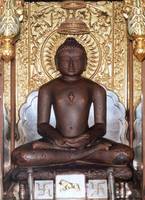
Idol of Mahāvīra
Image by Dayodaya © CC BY-SA 3.0
Images of the Jinas produced among the Digambara Mūrti-pūjaks are always naked, very plainly sculpted and have closed eyes. They do not wear any jewellery, although they may have have a kind of tilaka on the forehead and an endless knot on the chest.
This artistic Mūrti-pūjak tradition contrasts with Śvetāmbara Mūrti-pūjak statues of the Jinas, which have open eyes and loincloths, and are often painted and set in ornately sculpted altars and temples. This is because the Jina is thought of as a spiritual king and is frequently depicted with ornaments and pictured seated on a throne. Otherwise he wears only a loincloth or perhaps the simple white robe of a monk.
Reading
- Historical Dictionary of Jainism
Kristi L. Wiley - Historical Dictionaries of Religions, Philosophies, and Movements series; series editor Jon Woronoff; volume 53
Scarecrow Press; Maryland, USA; 2004
Links
- Images of Jinas
-
A few photographs of Jina images in various styles, ranging from tenth-century sculptures to a contemporary depiction, provided by Professor Frances W. Pritchett of Columbia University in New York.
- A Jina sits in meditation
-
The National Gallery of Australia provides this 12th-century image of a seated Jina. Under an ornate arch, the Jina takes the lotus pose of meditation. He is hard to identify without his emblem – lāñchana – but his closed eyes, unadorned figure and nudity indicate the statue was produced by the Digambara sect.
http://artsearch.nga.gov.au/Detail-LRG.cfm?IRN=128702&View=LRG
- Anointing a Jina statue
-
A statue of a Jina is ceremonially anointed during the festival of Dīvālī, the 'Festival of Lights' which marks the new year. For Jains the main celebration at Dīvālī is the commemoration of the liberation of the 24th Jina, Mahāvīra. A ‘head-anointing ceremony’ – mastakābhiṣeka – is a rite performed for any Jain image. Sanctified fluids are poured over the head of the statue, accompanied by a mantra or hymn. The sacred bath is at the centre of all Jain image rituals and can be performed daily in the morning ceremony or during festivals and pilgrimages. This photo on Flickr was taken in Jodhpur, Rajasthan in October 2009.
- Jina images and temples at Gwalior
-
The pilgrimage centre of Gwalior in central India is famous for its carvings of Jinas. Both freestanding and relief sculptures, the Jinas are found in the temples as well as in panels cut into walls of rock. This collection of drawings and photographs is presented by Professor Frances W. Pritchett of Columbia University in New York.
http://www.columbia.edu/itc/mealac/pritchett/00routesdata/1000_1099/jaintemples/gwalior/gwalior.html
- A Jina renounces
-
This highly decorated page from a 15th-century manuscript of the Kalpa-sūtra is provided by the National Gallery of Australia. A young man performs the rite of keśa-loca – ‘pulling out of the hair’ – which indicates indifference to the body. It is part of the initiation ceremony of dīkṣā, in which an initiate renounces the world and becomes a mendicant. He is watched by Śakra, king of the gods who takes an active role in the lives of the 24 Jinas.
http://artsearch.nga.gov.au/Detail-LRG.cfm?IRN=177852&View=LRG
- +
- aAbhavya
- aAbhinandana
- aAbhiṣeka
- aĀcāra
- aĀcārāṅga-sūtra
- aĀcārya
- aAchalbhrata
- aAḍhāī-dvīpa
- aAdharma
- aAdho-loka
- aAdhyayana
- aAdvaita Vedānta
- aĀgama
- aAghātīya
- aAghātīya-karman
- aAgnibhuti
- aAgra
- aĀhāra
- aAhiṃsā
- aAhimsa Day
- aAjita
- aAjīva
- aAkampit
- aĀkāśa
- aAkbar the Great
- aAkṣaya-tṛtīyā
- aAlauddin Khalji
- aAlbert Einstein
- aAllah
- aAlms
- aĀlocanā
- aAloka-ākāśa
- aAmāri
- aAmbikā or Kūṣmāṇḍinī
- aAnagāra
- aAnanta
- aAnarthadaṇḍa
- aAnaśana
- aAnekānta-vāda
- aAṅga
- aAniconism
- aAnojjā
- aAntarāla
- aAntarāya-karma
- aAṇu
- aAṇu-vrata
- aAnukampā
- aAnuprekṣā
- aAnusvāra
- aApabhraṃśa
- aAparigraha
- aAra
- aĀrambha
- aĀrambhaja
- aĀratī
- aArdhamāgadhī Prākrit
- aArhaṃ
- aArhat
- aArśana-āvaraṇīya-karma
- aĀrta-dhyāna
- aĀryikā
- aĀryikā Jñānamati
- aĀśātanā
- aĀścarya
- aAscetic
- aAsceticism
- aAshram
- aAspiration
- aĀsrava
- aAṣṭa-maṅgala
- aAṣṭāpada
- aAstikāya
- aAstrolabe
- aAsura
- aAtheism
- aAticāra
- aAtiśayakṣetra
- aAtithisaṃvibhāgavrata
- aĀtma-vāda
- aĀtman
- aAuṃ
- aAurangzeb
- aAuspicious
- aAusterity
- aAvadhāna
- aAvadhi-jñāna
- aĀvaraṇī-yakarman
- aAvasarpiṇī
- aAvatāra
- aAvidyā
- aAxiom
- aĀyāga-paṭa
- aĀyambil
- aĀyu-karma
- aĀyurveda
- bBabur
- bBāhubali
- bBaladeva
- bBālāvabodha
- bBandha
- bBasadi
- bBazaar
- bBhadrankarvijay
- bBhagavant
- bBhaktāmara-stotra
- bBhakti
- bBhale
- bBharata
- bBhāṣā
- bBhāṣya
- bBhaṭṭāraka
- bBhāva
- bBhāva-pūjā
- bBhāvanā
- bBhavana-vāsin
- bBhavya
- bBhavyatva
- bBhaya
- bBhoga-bhūmi
- bBhogopabhoga
- bBodhi
- bBollywood
- bBrahmā
- bBrahma-deva
- bBrahmacārī
- bBrāhmaṇa
- bBraj Bhāṣā
- bBright fortnight
- bBritish Raj
- bBuddha
- bBuddhi-sagar
- bBuddhism
- bBuddhist
- cCaitya
- cCaityavāsin
- cCakravartin
- cCakreśvarī
- cCāmara
- cCandanā
- cCandragupta
- cCandraprabha
- cCanon
- cCāritra
- cCāritramohanīya-karman
- cCarũrī
- cCaste
- cCaturvidha-saṅgha
- cCaturviṃśati-stava
- cCāturyāma
- cCE
- cCelibacy
- cCha
- cChadmastha
- cChastity
- cCheda-sūtra
- cChristian
- cChristianity
- cClergy
- cCloning
- cColophon
- cCommentary
- cConch
- cConfession
- cCongregation
- cConsecration
- cCosmology
- cCremation
- cCrore
- cCult
- cCūrṇi
- dDādā-guru
- dDalit
- dDāna
- dDaṇḍa
- dDark fortnight
- dDarśana
- dDarśanamohanī-yakarman
- dDaśa-lakṣaṇa-parvan
- dDeity
- dDelhi Sultanate
- dDerāsar
- dDeśāvakāśika-vrata
- dDetachment
- dDevanāgarī
- dDevānandā
- dDevarddhi-gani
- dDevotee
- dDhamal
- dDhanuṣ
- dDhāra
- dDharma
- dDharma-dhyāna
- dDharma-sāgara
- dDharmastikaya
- dDhātakīkhaṇḍa
- dDholak
- dDhyāna
- dDiaspora
- dDig-vrata
- dDigambara
- dDīkṣā
- dDisciple
- dDīvālī
- dDivya-dhvani
- dDNA
- dDoctrine
- dDogma
- dDonor
- dDoṣa
- dDravya
- dDravya-pūjā
- dDrone
- dDuṣamā
- dDuṣamā-duṣamā
- dDuṣamā-suṣamā
- dDveṣa
- dDvīpa
- eEast India Company
- eEightfold Path
- eEkānta-vāda
- eEkendriya
- eElder
- eElders
- eEschatology
- eEtc up to
- fFarmān
- fFast
- fFatehpur Sikri
- fFestival
- fFestschrift
- fFiruz Shah
- fFly-Whisks
- fFolio
- fFour Noble Truths
- gGaccha
- gGaṇa
- gGaṇadhara
- gGanadharavada
- gGaṇeśa
- gGaṇin
- gGarba
- gGarbha
- gGarbha-gṛha
- gGaruḍa
- gGati
- gGene
- gGenomics
- gGhātī-yakarman
- gGhātīya
- gGhaznavid
- gGhiyasuddin Tughlaq
- gGhurid
- gGloss
- gGotra-karma
- gGujarāt
- gGujarati
- gGuṇa
- gGuṇa-sthāna
- gGuṇa-vrata
- gGupti
- gGuru
- gGuruṇī
- hHagiography
- hHajj
- hHaṃsa
- hHaribhadra
- hHariṇaigameṣin
- hHasta
- hHeresy
- hHiṃsā
- hHindi
- hHindu
- hHinduism
- hHīravijaya
- hHoroscope
- hHrīṃ
- hHumayun
- hHymn
- iIconoclasm
- iIconography
- iIdol
- iIndian Independence
- iIndology
- iIndra
- iIndrabhūti Gautama
- iIndriya
- iInitiation
- iIntercession
- iInvocation
- iIQ
- iIslam
- iIslamicate
- iIṣṭadevatā
- iĪśvara
- jJagat
- jJahangir
- jJain
- jJaina Devanāgarī
- jJaina Śaurasenī
- jJaina-dharma
- jJainaśāsana
- jJainness
- jJaisalmer
- jJamāli
- jJambū-dvīpa
- jJames Burgess
- jJanma
- jJanma-kalyāṇa
- jJarā
- jJāti
- jJina
- jJina-āgama
- jJina-bhavana
- jJina-bimba
- jJina-mātā
- jJinacandra-sūri
- jJinadatta
- jJinaprabha
- jJīva
- jJñāna
- jJñāna-āvaraṇīya-karma
- jJñāna-āvarṇiya
- jJñānsundar
- jJyotiṣka
- kKāla
- kKālakācārya-kathā
- kKālidāsa
- kKalpa-sūtra
- kKalpa-vṛkṣa
- kKalyāṇaka
- kKalyanvijay
- kKamaṇḍalu
- kKamaṭha
- kKarma
- kKarma-bhūmi
- kKarma-grantha
- kKarma-prakṛti
- kKarma-vāda
- kKarmon
- kKarnataka
- kKaṣāya
- kKathā
- kKāvya
- kKāya
- kKāyotsarga
- kKeśa-loca
- kKetu
- kKevala-jñāna
- kKevalin
- kKhalji
- kKharatara-gaccha
- kKnowledge
- kKriyā
- kKriyā-vāda
- kKṛṣṇa
- kKṣamā-śramaṇa
- kKṣapakaśreṇi
- kKṣatriya
- kKṣullaka
- kKulakara
- kKundakunda
- kKunthu
- lLabdhi
- lLaity
- lLakh
- lLāñchana
- lLands of Action
- lLaukāntika
- lLavaṇa-samudra
- lLeśyā
- lLiṅga
- lLinguistics
- lLoka
- lLoka-ākāśa
- lLoka-puruṣa
- lLoka-vāda
- lLotus
- lLotus lake
- mMadhya-loka
- mMahā-videha
- mMahā-vrata
- mMahābhārata
- mMahāmastakābhiṣeka
- mMāhārāṣṭra
- mMāhārāṣṭrī Prākrit
- mMahattarā Yākinī
- mMahāvīr Jayantī
- mMahāvīra
- mMakāra
- mMakkhali Gośāla
- mMalli
- mMāna-stambha
- mManaḥ-paryāya-jñāna
- mMaṇḍala
- mMaṇḍapa
- mMandit
- mMaṅgala
- mMantra
- mMantras
- mManuṣya-loka
- mMarāṭhī
- mMārgaṇā
- mMartyr
- mMarudevī
- mMaṭha
- mMati-jñāna
- mMauryaputra
- mMecca
- mMendicant lineage
- mMetarya
- mMiracle
- mMithyādṛṣṭi
- mMohandas Gandhi
- mMohanīya-karma
- mMokṣa
- mMonastic order
- mMonasticism
- mMonk
- mMonotheism
- mMosque
- mMount Meru
- mMount Sammeta
- mMṛgāvatī
- mMughal
- mMuhammad
- mMuhammad bin Tughlaq
- mMuhpattī
- mMūla-sūtra
- mMūlaguṇa
- mMumbaī
- mMuni
- mMunisuvrata
- mMurad Bakhsh
- mMūrti-pūjaka
- mMuslim
- mMysticism
- nNābhi
- nNāga-kal
- nNāgapurīya Tapā-gaccha
- nNāgarī
- nNāma-karma
- nNamaskāra-mantra
- nNami
- nNandīśvara-dvīpa
- nNandivardhana
- nNandyāvarta
- nNāraka
- nNāraki
- nNasalisation
- nNātha
- nNavrātrī
- nNaya-vāda
- nNemi
- nNidāna
- nniggaṃthāṇa vā 2
- nniggaṃtho vā 2
- nNigoda
- nNihnava
- nNikṣepa
- nNirgrantha
- nNirjarā
- nNirvāṇa
- nNiryukti
- nNiṣidhi
- nNitya
- nNiyati
- nNo-kaṣāya
- nNudity
- nNun
- oOcean of milk
- oOmniscience
- oOrdination
- ppa°
- pPadmaprabha
- pPadmāsana
- pPadmāvatī
- pPādukā
- pPalanquin
- pPalette
- pPañca-muṣṭi
- pPāṇḍava
- pPaṇḍit
- pPandit Dalsukh D. Malvania
- pPandit Sukhlalji
- pPāṇipātra
- pPāpa
- pParamātman
- pParameṣṭhin
- pPāraṇā
- pParigraha
- pPariṇāma
- pParīṣaha
- pParokṣa
- pPārśva
- pPārśvanātha
- pParyāya
- pParyuṣaṇ
- pPaṭa
- pPatan
- pPātra
- pPenance
- pPersian
- pPhala
- pPhilology
- pPicchikā
- pPilgrimage
- pPīr
- pPolymath
- pPoṣadha
- pPossession
- pPothī
- pPrabhas
- pPradakṣiṇā
- pPradeśa
- pPrākāra
- pPrakīrṇaka-sūtra
- pPrākrit
- pPramāda
- pPramukhā
- pPrati-vāsudeva
- pPratikramaṇa
- pPratimā
- pPratiṣṭhā
- pPratyākhyāna
- pPratyakṣa
- pPravacana
- pPrāyaścitta
- pPrayer
- pPre-modern
- pPreach
- pPredestination
- pProtestant
- pProvenance
- pPudgala
- pPūjā
- pPujārī
- pPukharavara-dvīpa
- pPuṇya
- pPūrva
- pPuṣkara-dvīpa
- pPuṣpadanta
- pPyre
- qQur’an
- rRāga
- rRāhu
- rRainy season
- rRajasthan
- rRajasthani
- rRājimatī
- rRajoharaṇa
- rRajput
- rRāma
- rRāmāyaṇa
- rRangoli
- rRās-garbā
- rRasa
- rRathanemi
- rRatna-traya
- rRātri-bhojana
- rRaudra-dhyāna
- rRecto
- rRelic
- rRenunciation
- rRetroflex
- rRevatī
- %Ṛg-veda
- rRite
- rRosary
- %Ṛṣabha
- %Ṛṣabhanātha
- rRupee
- sSaciyā Mātā
- sSādhu
- sSādhvī
- sSāgāra
- sSaint
- sŚaivaism
- sŚaka-saṃvat
- sSallekhanā
- sŚalya
- sSamacatuṣṭha
- sSamādhimaraṇa
- sSamaṇi
- sSāmarambha
- sSamavasaraṇa
- sSāmāyika
- sSaṃbhava
- sSamiti
- sSaṃjñā
- sSaṃkalpaja
- sSaṃsāra
- sSamudghāta
- sSaṃvara
- sSaṃvega
- sSamyak-cāritra
- sSamyak-darśana
- sSamyak-jñāna
- sSamyaktva
- sSaṃyama
- sSanctuary
- sSandalwood
- sSaṇgha
- sSanskrit
- sSant
- sŚānti
- sSapta-bhaṅgi-naya
- sSārambha
- sSarasvatī
- sSarvajña
- sSāsan-devi
- sŚāsana-devatā
- sŚāstra
- %Ṣaṭ-jīvanikāya
- sSatī
- sSatīmātā
- sSatya
- sSchism
- sScribe
- sScripture
- sSect
- sSecularism
- sŚenāī
- sSermon
- sŚeṣavatī
- sSevā
- sSeven fields of donation
- sShah Jahan
- sShantidas Jhaveri
- sShrine
- sSiddha
- sSiddha-śilā
- sSiddhacakra or Navadevatā
- sSiddhānta
- sSiddhārtha
- sSiddhi
- sSikh
- sSikhism
- sŚikṣā-vrata
- sŚīla
- sSin
- sSindh
- sŚītala
- sŚiva
- sSkandha
- sSomanatha
- sŚraddhā
- sŚramaṇa
- sŚrāvaka
- sŚrāvakācāra
- sŚrāvikā
- sŚreyāṃsa
- sŚrī
- sŚrīvatsa
- sŚruta-jñāna
- sŚruta-pañcamī
- sSthānaka-vāsin
- sSthāpanācārya
- sSthāvara
- sSthavira
- sSthiti
- sStrīmukti
- sStūpa
- sSubcontinent
- sSudarshana
- sŚuddhi
- sSudharma
- sŚūdra
- sSufism
- sSukha
- sŚukla-dhyāna
- sSulasā
- sSultan
- sSumati
- sSundarśrī
- sSupārśva
- sSūri
- sSuṣamā
- sSuṣamā-duṣamā
- sSuṣamā-suṣamā
- sSūtra
- sSuyam me ausam! Tenam bhagavaya evamakkhayam
- sSvādhyāya
- sSvāhā
- sSvastika
- sŚvetāmbara
- sŚvetāmbara Terāpanthin
- sŚvetāmbaras
- sSwan
- sSyād-vāda
- tTabla
- tTantra
- tTapā-gaccha
- tTapas
- tTāraṇ Svāmī Panth
- tTattva
- tTattvārtha-sūtra
- tTemple
- tTemple-city
- tThe Enlightenment
- tTheology
- tThree worlds
- %Ṭīkā
- tTilaka
- tTīrtha
- tTīrthaṃkaranāma-karman
- tTīrthankara
- tTransliteration
- tTrasa
- tTrasa-nāḍī
- tTriśalā
- tTriṣaṣṭi-śalākā-puruṣa-caritra
- tTti bemi
- tTughlaq
- tTunk
- uUdumbara
- uUniversal History
- uUpādhyāya
- uUpāṅga
- uUpaniṣads
- uUpāsaka
- uUpasarga
- uUpāśraya
- uŪrdhva-loka
- uUtsarpiṇī
- uUttarādhyayana-sūtra
- vVāhana
- vVaimānika
- vVairāgya
- vVaiṣṇava
- vVaiśramaṇa
- vVaiśya
- vValabhī
- vVanaspatikāya
- vVandana
- vVaṇik
- vVarṇa
- vVāsudeva
- vVāsupūjya
- vVayubhūti
- vVeda
- vVedanīya-karma
- vVegetarianism
- vVehicle
- vVernacular
- vVerso
- vVidyā
- vVidyā-devī
- vVihāra
- vVijñapti-patra
- vVikrama-saṃvat
- vVikṛti
- vVimala
- vVinaya
- vVipāka
- vVirji Vora
- vVirodhaja
- vVīrya
- vVisarga
- vViṣṇu
- vVītarāga
- vVizier
- vVotive
- vVow
- vVrata
- vVS
- vVyakta
- vVyantara
- vVyasana
- yYakṣa
- yYakṣī
- yYantra
- yYaśoda
- yYaśovijaya
- yYati
- yYātrā
- yYoga
- yYoginī
- yYojana


